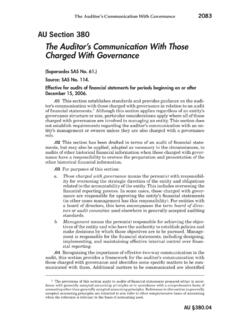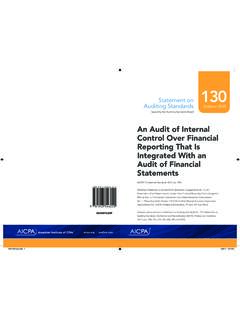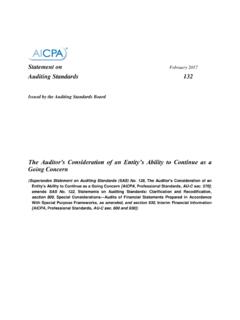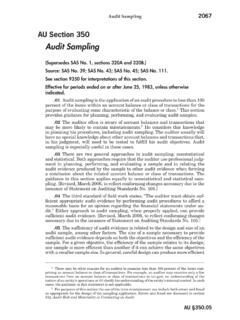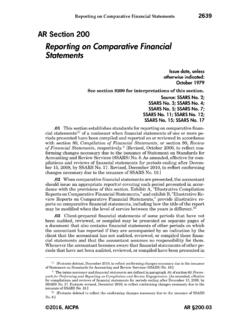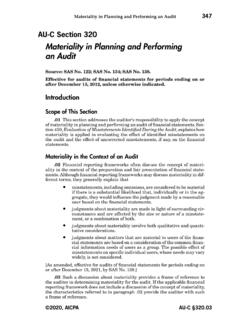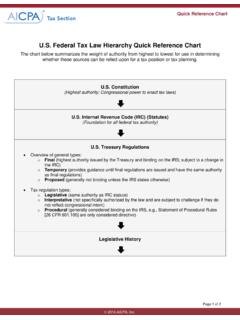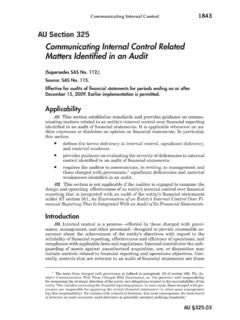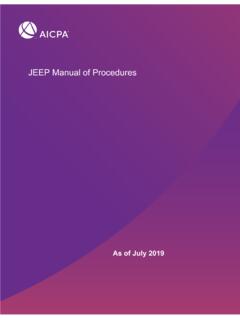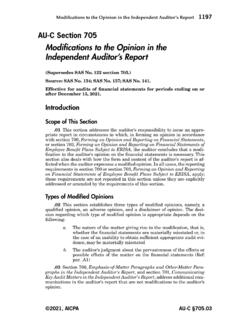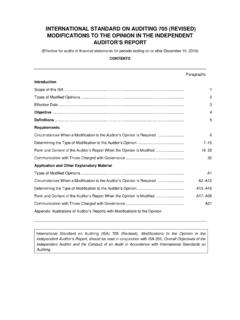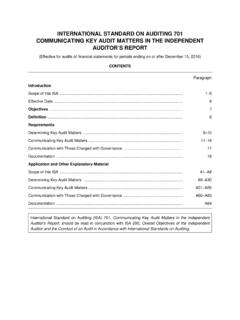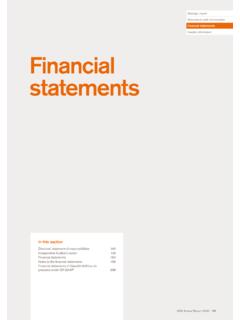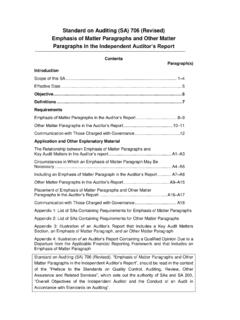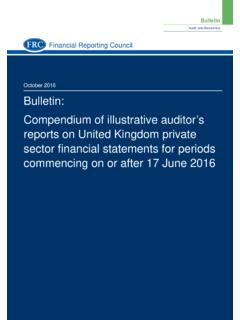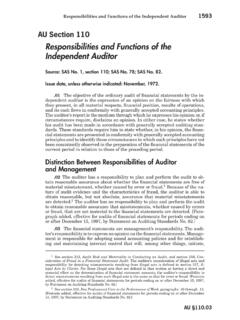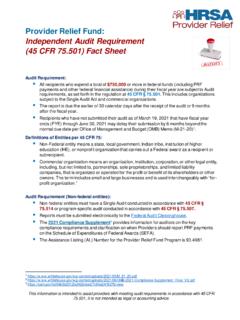Transcription of Overall Objectives of the Independent Auditor and the ...
1 Overall Objectives of the Independent Auditor81AU-C Section 200 Overall Objectives of the Independent Auditorand the Conduct of an Audit in AccordanceWith Generally Accepted Auditing StandardsSource: SAS No. 122; SAS No. 123; SAS No. 128; SAS No. 130; SAS ; SAS No. 136; SAS No. for audits of financial statements for periods ending on orafter December 15, 2012, unless otherwise of This section addresses the Independent Auditor 's Overall responsibili-ties when conducting an audit of financial statements in accordance with gen-erally accepted auditing standards (GAAS). Specifically, it sets out the overallobjectives of the Independent Auditor (the Auditor ) and explains the nature andscope of an audit designed to enable the Auditor to meet those Objectives . It alsoexplains the scope, authority, and structure of GAAS and includes requirementsestablishing the general responsibilities of the Auditor applicable in all engage-ments conducted in accordance with GAAS, including the obligation to complywith GAAS.
2 [As amended, effective for audits for periods ending on or afterDecember 15, 2016, by SAS No. 130.].02 GAAS are developed and issued in the form of Statements on Audit-ing Standards (SASs) and are codified into AU-C sections. GAAS are writtenin the context of an audit of financial statements by an Auditor . They are to beadapted as necessary in the circumstances when applied to other engagementsconducted in accordance with GAAS, such as audits of other historical financialinformation, compliance audits, and audits of internal control over financial re-porting that are integrated with audits of financial statements. GAAS do notaddress the responsibilities of the Auditor that may exist in legislation, regu-lation, or otherwise, in connection with, for example, the offering of securitiesto the public.
3 Such responsibilities may differ from those established in , although the Auditor may find aspects of GAAS helpful in suchcircumstances, it is the responsibility of the Auditor to ensure compliance withall relevant legal, regulatory, or professional obligations. [As amended, effectivefor audits for periods ending on or after December 15, 2016, by SAS No. 130.]Association With Financial Auditor is associated with financial information when the audi-tor has applied procedures sufficient to permit the Auditor to report in accor-dance with GAAS. Statements on Standards for Accounting and Review Ser-vices address the accountant's considerations when the accountant preparesand presents financial statements to the entity or to third parties. 2020, AICPAAU-C Principles and ResponsibilitiesAn Audit of Financial purpose of an audit is to provide financial statement users with anopinion by the Auditor on whether the financial statements are presented fairly,in all material respects, in accordance with an applicable financial reportingframework, which enhances the degree of confidence that intended users canplace in the financial statements.
4 An audit conducted in accordance with GAASand relevant ethical requirements enables the Auditor to form that opinion.(Ref: par..A1).05 The financial statements subject to audit are those of the entity, pre-pared and presented by management of the entity with oversight from thosecharged with governance. GAAS do not impose responsibilities on managementor those charged with governance and do not override laws and regulationsthat govern their responsibilities. However, an audit in accordance with GAASis conducted on the premise that management and, when appropriate, thosecharged with governance have acknowledged certain responsibilities that arefundamental to the conduct of the audit. The audit of the financial statementsdoes not relieve management or those charged with governance of their respon-sibilities.
5 (Ref: par..A2 .A13).06As the basis for the Auditor 's opinion, GAAS require the Auditor to ob-tain reasonable assurance about whether the financial statements as a wholeare free from material misstatement, whether due to fraud or error. Reason-able assurance is a high, but not absolute, level of assurance. It is obtainedwhen the Auditor has obtained sufficient appropriate audit evidence to reduceaudit risk (that is, the risk that the Auditor expresses an inappropriate opinionwhen the financial statements are materially misstated) to an acceptably lowlevel. Reasonable assurance is not an absolute level of assurance because thereare inherent limitations of an audit that result in most of the audit evidence,on which the Auditor draws conclusions and bases the Auditor 's opinion, beingpersuasive rather than conclusive.
6 (Ref: par..A32 .A56).07 The concept of materiality is applied by the Auditor when both plan-ning and performing the audit, and in evaluating the effect of identified mis-statements on the audit and uncorrected misstatements, if any, on the general, misstatements, including omissions, are considered tobe material if there is a substantial likelihood that, individually or in the ag-gregate, they would influence the judgment made by a reasonable user basedon the financial statements. Judgments about materiality are made in lightof surrounding circumstances, and involve both qualitative and quantitativeconsiderations. These judgments are affected by the Auditor 's perception of thefinancial information needs of users of the financial statements, and by thesize or nature of a misstatement, or both.
7 The Auditor 's opinion addresses thefinancial statements as a whole. Therefore, the Auditor has no responsibilityto plan and perform the audit to obtain reasonable assurance that misstate-ments, whether caused by fraud or error, that are not material to the financialstatements as a whole, are detected. (Ref: par..A14) [As amended, effective foraudits of financial statements for periods ending on or after December 15, 2021,by SAS No. 138.].08 GAAS contain Objectives , requirements, and application and otherexplanatory material that are designed to support the Auditor in obtainingreasonable assurance. GAAS require that the Auditor exercise professional1 See section 320,Materiality in Planning and Performing an Audit, and section 450,Evaluationof Misstatements Identified During the 2020, AICPAO verall Objectives of the Independent Auditor83judgment and maintain professional skepticism throughout the planning andperformance of the audit and, among other things, identify and assess risks of material misstatement, whether dueto fraud or error, based on an understanding of the entity and itsenvironment, including the entity's internal control.
8 Obtain sufficient appropriate audit evidence about whether ma-terial misstatements exist, through designing and implementingappropriate responses to the assessed risks. form an opinion on the financial statements, or determine thatan opinion cannot be formed, based on an evaluation of the auditevidence form of opinion expressed by the Auditor will depend upon theapplicable financial reporting framework and any applicable law or Auditor also may have certain other communication and report -ing responsibilities to users, management, those charged with governance, orparties outside the entity, regarding matters arising from the audit. These re-sponsibilities may be established by GAAS or by applicable law or section is effective for audits of financial statements for periodsending on or after December 15, Objectives of the Overall Objectives of the Auditor , in conducting an audit of financialstatements, are reasonable assurance about whether the financial state-ments as a whole are free from material misstatement, whetherdue to fraud or error, thereby enabling the Auditor to express anopinion on whether the financial statements are presented fairly,in all material respects, in accordance with an applicable financialreporting framework.
9 On the financial statements, and communicate as requiredby GAAS, in accordance with the Auditor 's all cases when reasonable assurance cannot be obtained and a qual-ified opinion in the Auditor 's report is insufficient in the circumstances for pur-poses of reporting to the intended users of the financial statements, GAAS re-quire that the Auditor disclaim an opinion or withdraw from the engagement,when withdrawal is possible under applicable law or purposes of GAAS, the following terms have the meanings at-tributed as follows:Applicable financial reporting financial report -ing framework adopted by management and, when appropriate,2 For examples, see section 260,The Auditor 's Communication With Those Charged With Gov-ernance; section 265,Communicating Internal Control Related Matters Identified in an Audit;andparagraph.
10 42 of section 240,Consideration of Fraud in a Financial Statement Audit. 2020, AICPAAU-C Principles and Responsibilitiesthose charged with governance in the preparation and fair pre-sentation of the financial statements that is acceptable in view ofthe nature of the entity and the objective of the financial state-ments, or that is required by law or used by the Auditor in arriving atthe conclusions on which the Auditor 's opinion is based. Auditevidence includes both information contained in the accountingrecords underlying the financial statements and other of audit evidenceis the measure of the quantityof audit evidence. The quantity of the audit evidence needed isaffected by the Auditor 's assessment of the risks of material mis-statement and also by the quality of such audit of audit evidenceis the measure of the quality of auditevidence; that is, its relevance and its reliability in providing sup-port for the conclusions on which the Auditor 's opinion is risk that the Auditor expresses an inappropriateaudit opinion when the financial statements are materially mis-stated.
